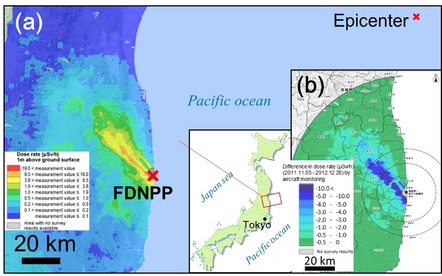March 09, 2016
Five years ago, the Great East Japan Earthquake hit the Tohoku district causing 19,335 deaths; 2,600 people are still missing. The Fukushima Daiichi Nuclear Disaster, at level seven on the International Nuclear Event Scale (INES), released ~520 PBq of radionuclides and forced residents to evacuate miles away from the contaminated area. During the past five years, a large number of articles have been published on the earthquake and the subsequent events, including the radioactive Cs contamination on the land in Fukushima prefecture and in the ocean (geochemical NEWSin August 25, 2015).
Radioactive Cs contamination in the surface environment has been a serious issue and will remain so for decades to come given the half-lives of 134Cs and 137Cs are 2.06 and 30.07 years, respectively. Radioactive Cs is rigidly bound in interlayers of clay minerals and is retained in the surface soils (e.g., Kaneko et al., 2015). However, aircraft monitoring revealed that the radiation dose decreased faster than expected based on the Cs half lives (Fig. 1b), indicating that soil particles associated with Cs were transported through surface waters into the ocean (e.g., Yamasaki et al., 2016). In addition to Cs bound to clay minerals, Cs-rich micro-particles (~ a few μm), mainly composed of Si oxide glass associated with wt% level Cs and other metals, were recently reported (Adachi et al., 2013). Despite their low numbers, these Cs-rich micro-particles may be a considerable dose contributor to the ecosystem. In addition, the formation processes of these Cs-rich micro-particles can provide novel information on the reaction that happened inside the reactor pressure vessel (RPV) and the primary containment vessel (PCV) when the fuels melted down in units 1 and 3 at the Fukushima Daiichi Nuclear Power Plant (FDNPP). The decommission of units 1~4 is ongoing and the most difficult process will be the removal of fuel debris, which is a solidified form of the melted fuel mixed with cladding, other metals, and possibly concrete. Even the occurrence and properties of the debris are totally unknown at the present, because it is difficult to sample the debris and investigate the occurrence inside the PCV due to the extremely high radiation dose. Since the Cs-rich micro-particles contain some fission products, they provide valuable insights into the chemical reactions that occurred inside the PCV during the explosions. The Fukushima disaster will challenge many geochemists as the long-term issues including debris, contaminated water stored in tanks, and Cs contamination in the soils, are resolved.
Dr. Satoshi Utsunomiya, Department of Chemistry, Kyushu University
744 Motooka, Nishi-ku,¥
Fukuoka-shi, 819-0395 JAPAN
References
1. M. Kaneko, H. Iwata, H. Shiotsu, S. Masaki, Y. Kawamoto, S. Yamasaki, Y. Nakamatsu, J. Imoto, G. Furuki, A. Ochiai, K. Nanba, T. Ohnuki, R. C. Ewing& S. Utsunomiya, Radioactive Cs in the severely contaminated soils near the Fukushima Daiichi nuclear power plant. Frontiers in Energy Research, (2015) dx.doi.org/10.3389/fenrg.2015.00037
2. S. Yamasaki, J. Imoto, G. Furuki, A. Ochiai, T. Ohnuki, K. Sueki, K. Nanba, R. C. Ewing, & S. Utsunomiya, Radioactive Cs in the estuary sediments near Fukushima Daiichi Nuclear Power Plant. Science of the Total Environment, 551-552 (2016) 155-162.
3. K. Adachi, M. Kajino, Y. Zaizen, & Y. Igarashi, Emission of spherical cesium-bearing particles from an early stage of the Fukushima nuclear accident, Scientific Reports, 3 (2013) 2554/1-5.

Fig. 1. (a) A map of dose rate in Fukushima based on an airplane monitoring survey by MEXT in May 2012. FDNPP represent the Fukushima Daiichi Nuclear Power Plant. (b) The difference in dose rate between November, 2011 and December, 2012. Approximately 40% of the radiation dose has decreased due to the radioactive decay and physical removal of surface soils.